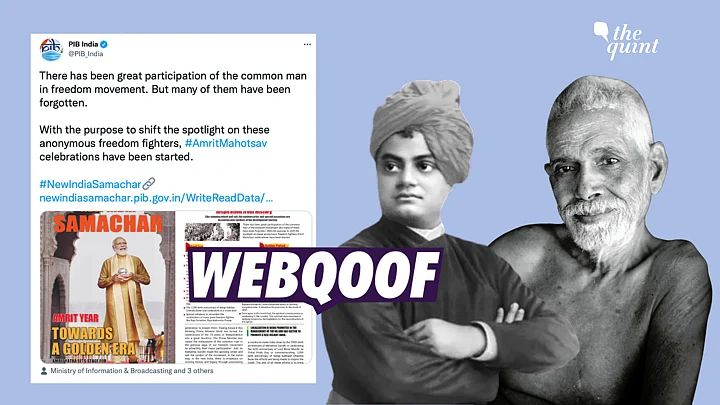The Press Information Bureau (PIB) of India’s verified Twitter handle shared pages from the latest issue of the government’s fortnightly e-Magazine New India Samachar. The issue marked the ‘Amrut Mahotsav’, which celebrates India in its 75th year of Independence.
The text on one of the pages speaks about the 'Bhakti movement' in India and how it “heralded” the freedom struggle in India.
Naming religious leaders and saints, it goes on to say that Swami Vivekananda and Ramana Maharishi were concerned about the country’s “spiritual consciousness”. It then adds that the movement served as a precursor to the revolt of 1857.
However, we found that both of them could not have had any influence on the revolt of 1857, which is widely regarded as India’s first war of Independence, as both of them were born after 1857.
As per books and records, Swami Vivekananda was born in 1863 whereas Ramana Maharishi was born in 1879, six and 22 years after revolt respectively.
CLAIM
The pages were shared by the Press Information Bureau of India’s verified Twitter account.
WHAT WE FOUND OUT
First, we sought to verify the birth years of – Swami Vivekananda, Chaitanya Mahaprabhu and Ramana Maharishi.
In his biography of Swami Vivekananda titled Vivekananda: A Biography, eminent writer and thinker Swami Nikhilananda noted the details of Vivekananda’s birth.
The biography notes that Vivekananda was born as Narendranath Datta on 12 January 1863, a few minutes after sunrise in Kolkata (formerly Calcutta) in India.
In his lifetime, Vivekananda founded the Belur Math in Howrah, West Bengal, which serves as the headquarters of the Ramakrishna Mission and houses a temple under Vivekananda’s name, built at the spot of his cremation.
Belur Math’s website carries a profile of Vivekananda, which also states his birth year as 1863.
We then sought to verify Ramana Maharshi’s birth year.
In an excerpt of a book titled Living by the Words of Bhagavan, which chronicled the relationship between Maharshi and his devotee, Annamalai Swami, author David Godman wrote, “In 1896, while he was still a sixteen-year-old schoolboy…”
This places Ramana Maharshi’s year of birth around the year 1880, 23 years after the revolt in India.
We then came across a page for the sage on Britannica Encyclopaedia’s website, which said that he was born in 1879 in Madurai, Tamil Nadu.
Next, we looked at a book titled ‘Face to Face with Sri Ramana Maharishi,’ an anthology of over 200 stories about the sage. Its preface mentions that the Maharshi was born in 1879 and died in 1950.
We also found a web version of a book titled Ramana Maharshi: The Sage of Arunachala, which also noted that he was born on 30 December 1879 at one in the morning.
Further, Chaitanya Mahaprabhu was a 15th century monk, who was born in Mayapur in 1486, as per information available on the website of Sri Radha Raman Sena Charitable Trust.
The same information is provided in an article by historian Amiya P Sen for The Telegraph.
BUT, WHAT WAS THE BHAKTI MOVEMENT?
A social movement, which probably started in Tamil Nadu, around the 6th and 7th century AD to empower those on the lower rungs of the society.
It was in the 12th century, that the movement was started by Basavanna in the Kannada region. During this period, they produced literature that was known as 'Vachana sahitya'. It challenged caste hierarchy, emphasised on a person's direct connection to god and possibility of salvation through good deeds.
The movement began in Maharashtra in the 13th century and later in Northern India.
So clearly, while the movement may or may not have played a role in the Revolt of 1857, neither Swami Vivekananda nor Ramana Maharshi’s actions could have acted as a precursor, as they were both born after the rebellion against the British rule.
(Not convinced of a post or information you came across online and want it verified? Send us the details on WhatsApp at 9643651818, or e-mail it to us at webqoof@thequint.com and we'll fact-check it for you. You can also read all our fact-checked stories here.)
